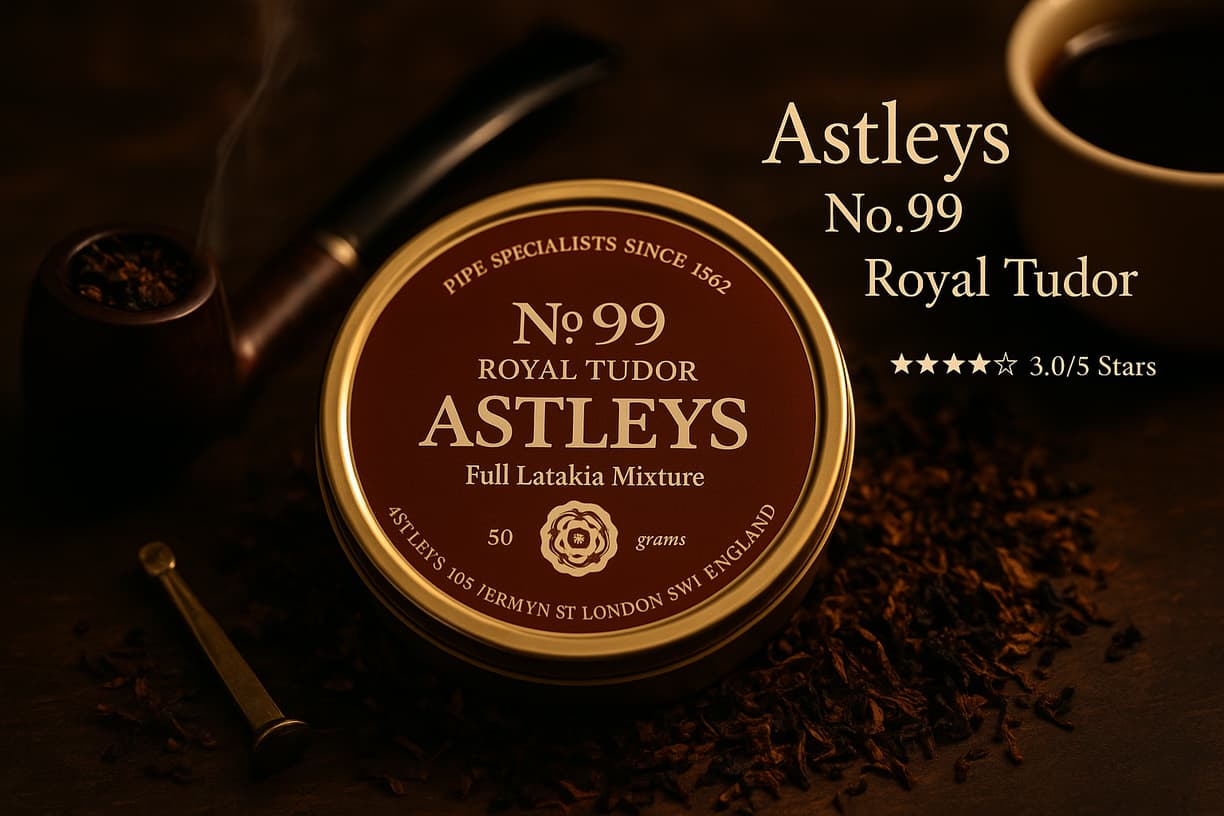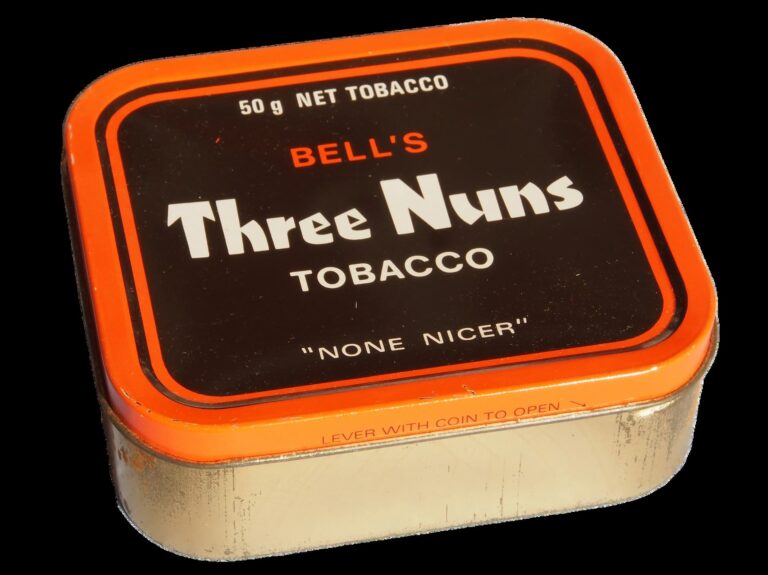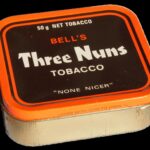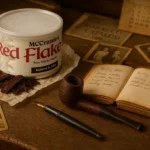- Tobacco Name: Astley’s No.99 Royal Tudor Full Latakia Mixture
- Manufacturer: Kohlhase & Kopp
- Original Manufacturer: Astley’s (London, England)
- Blend Type: English
- Cut Type: Ribbon
- Strength Level: Medium
- Overall Rating: 3.0
- Primary Tobaccos: Latakia, Oriental, Turkish, Virginia
- Similar Blends: Dunhill Early Morning Pipe, Peterson Early Morning Mixture, Rattray’s Red Rapparee
- Recommended Pairings: Black coffee, single malt whisky, dark beer, aged rum
- Recommended For: English blend enthusiasts, medium-strength seekers, traditional tobacco lovers
- Avoid If: Latakia-sensitive smokers, aromatic-only preferences, beginners to English blends
- Tin Note/Aroma: 3.5
- Flavor Development: 3.0
- Burn Quality: 3.5
- Smoothness: 4.0
- Recommend: 3.0
- Pipe Smoked: Peterson System Standard 303
- Availability: Discontinued
Essential Information
TL;DR
Astley’s No.99 Royal Tudor Full Latakia Mixture represents a fascinating chapter in English tobacco history, now sadly closed with its discontinuation by Kohlhase & Kopp. This traditional English blend delivers a surprisingly balanced Latakia experience, where the smoky Syrian leaf plays supporting actor rather than dominating the stage. The Oriental and Turkish tobaccos provide the real character here, offering spicy, woody notes that dance beautifully with the Virginia base. At medium strength, it’s approachable for most smokers while maintaining enough complexity to satisfy experienced palates. The ribbon cut burns consistently, requires minimal maintenance, and produces a tolerable room note. While not groundbreaking, it exemplifies solid English blending principles. For those fortunate enough to find remaining stock, it offers a glimpse into traditional tobacco craftsmanship, though its discontinuation means this review serves more as historical documentation than purchasing guide.
The Experience: A Deep Dive into Astley’s No.99 Royal Tudor Full Latakia Mixture by Kohlhase & Kopp
First Impressions
Tin Note: Opening a fresh tin of Astley’s No.99 Royal Tudor immediately transports you to a bygone era of English tobacco shops. The aroma rises with the dignified restraint characteristic of traditional English blends—no aggressive Latakia assault here, but rather a sophisticated introduction. The initial nose reveals plummy, raisin-like sweetness from well-aged Virginia tobaccos, their natural sugars having developed into complex fruit notes. Beneath this foundation, the Latakia whispers rather than shouts, contributing woody, campfire-like undertones that suggest autumn evenings and leather-bound libraries. The Oriental and Turkish components add their distinctive spicy, almost incense-like character, creating an aromatic tapestry that speaks of careful blending and patient maturation. There’s an old-world elegance to this tin note—nothing harsh or acrid, just the gentle complexity that made English blends legendary.
Appearance: The ribbon cut presents beautifully in the tin, showcasing the artistry of traditional tobacco preparation. Ribbons of varying hues create a visual symphony: deep black strands of Latakia interweave with golden-brown Virginia pieces, while darker brown Oriental leaves add textural contrast. The cut is neither too fine nor too coarse, achieving that perfect middle ground that experienced blenders prize. The tobacco feels properly conditioned—not bone dry, not overly moist—with just enough natural oils to ensure easy packing and consistent burning. Light green strips occasionally catch the eye, likely representing the brighter Virginia components that provide the blend’s underlying sweetness. The overall presentation speaks to quality control and attention to detail, characteristics that defined the Astley’s brand throughout its storied history.
The Smoke: Journey Through the Bowl
Packing and Lighting: Astley’s No.99 Royal Tudor demonstrates the user-friendly nature of well-prepared ribbon cuts. The tobacco packs effortlessly into my Peterson System Standard 303, requiring no special technique or excessive manipulation. The ribbon cut’s uniform texture allows for consistent density throughout the bowl, eliminating the hot spots and uneven burning that plague poorly prepared tobaccos. Initial lighting proves straightforward—the tobacco accepts flame readily without excessive charring or false lights. The first few puffs reveal a blend that’s been properly conditioned, neither requiring extensive drying time nor suffering from over-humidification. This technical excellence reflects the German precision that Kohlhase & Kopp brought to their tobacco production, ensuring that smokers could focus on flavor rather than fighting mechanical issues.
Initial Flavor: The opening third of the bowl establishes Astley’s No.99 Royal Tudor as a gentleman’s English blend—refined, balanced, and thoroughly civilized. The Latakia announces itself with characteristic smokiness, but this isn’t the overwhelming Syrian leaf bomb that dominates lesser English mixtures. Instead, it provides a woody, campfire-like backdrop that enhances rather than masks the other components. The Virginia tobaccos contribute their natural sweetness immediately, offering notes of hay, honey, and subtle citrus that brighten the overall profile. Most impressively, the Oriental and Turkish tobaccos assert themselves from the very first puff, delivering the spicy, almost peppery character that distinguishes quality English blends. There’s a pleasant earthiness here, reminiscent of autumn leaves and old wood, that speaks to the blend’s traditional roots. The nicotine delivery remains moderate, providing gentle satisfaction without overwhelming newer smokers or disappointing veterans seeking substance.
Mid-Bowl: As the bowl progresses into its middle third, Astley’s No.99 Royal Tudor reveals its true character through subtle evolution and deepening complexity. The Latakia, initially prominent, begins to recede slightly, allowing the Oriental and Turkish components to step forward and claim center stage. This transition demonstrates the skill of the original blenders, who understood that great English mixtures should tell a story rather than simply deliver static flavor. The Oriental tobaccos now display their full range, offering notes of leather, spice, and exotic woods that transport the smoker to distant bazaars and ancient trade routes. The Turkish leaf adds its distinctive tartness, a pleasant sourness that balances the Virginia sweetness and prevents the blend from becoming cloying. Throughout this middle section, the burn remains remarkably consistent, requiring only occasional attention to maintain proper combustion. The room note during this phase proves tolerable to pleasant, lacking the acrid harshness that makes some English blends unwelcome in polite company.
Finish: The final third of Astley’s No.99 Royal Tudor provides a satisfying conclusion to this traditional English experience. The Latakia, having played its supporting role throughout the bowl, now integrates completely with the other components, creating a harmonious finish that avoids the bitter, ashy notes that plague inferior blends. The Virginia tobaccos maintain their sweetness to the very end, preventing the harsh, tongue-biting finish that can ruin an otherwise pleasant smoke. The Oriental and Turkish elements continue their spicy dance, now mellowed and rounded by the heat and time, offering a gentle complexity that invites contemplation. The final puffs deliver a clean, satisfying conclusion with minimal dottle and no unpleasant aftertaste. This is tobacco blending as it should be—thoughtful, balanced, and respectful of both the leaf and the smoker.
Room Note: The ambient aroma of Astley’s No.99 Royal Tudor falls squarely into the “tolerable to pleasant” category, making it suitable for indoor smoking where consideration for others matters. Unlike aggressive Latakia bombs that clear rooms and strain relationships, this blend produces a gentle, woody fragrance that most non-smokers find inoffensive. The room note carries hints of the campfire smokiness from the Latakia, but tempered by the sweeter Virginia components and the exotic spice of the Orientals. There’s an old-world charm to this ambient aroma—it evokes images of English gentlemen’s clubs, leather chairs, and quiet contemplation rather than the harsh, industrial smell of poorly balanced tobaccos.
Strength: Astley’s No.99 Royal Tudor delivers a solid medium strength that satisfies without overwhelming. The nicotine content provides gentle satisfaction for experienced smokers while remaining approachable for those with moderate tolerance. This strength level makes it suitable for all-day smoking, though its complexity deserves the attention of dedicated smoking sessions rather than casual background consumption. The blend avoids the weakness that makes some English mixtures feel insubstantial while steering clear of the overwhelming power that can make stronger blends punishing for extended sessions.
Final Thoughts: Verdict on Astley’s No.99 Royal Tudor Full Latakia Mixture
Overall Assessment
Overall Impression: Astley’s No.99 Royal Tudor Full Latakia Mixture stands as a testament to traditional English blending artistry, representing both the strengths and limitations of conservative tobacco craftsmanship. This blend succeeds admirably in its modest ambitions—delivering a balanced, approachable English mixture that honors the genre’s conventions without pushing boundaries or challenging expectations. The integration of Latakia, Oriental, Turkish, and Virginia tobaccos demonstrates competent blending, creating a harmonious whole where no single component dominates inappropriately. While it may not achieve the transcendent heights of legendary English blends, it provides consistent, reliable satisfaction that many smokers will appreciate. The blend’s greatest strength lies in its accessibility—this is English tobacco for those who want to understand the style without confronting its more challenging expressions. Its greatest weakness is perhaps its very respectability; in an era of bold, innovative blending, Astley’s No.99 Royal Tudor feels almost quaint in its traditional approach.
Smoking Experience: From a technical standpoint, Astley’s No.99 Royal Tudor performs admirably throughout the smoking experience. The ribbon cut burns consistently and evenly, requiring minimal intervention from the smoker. The moisture content proves ideal, eliminating the need for extensive drying while avoiding the harsh, over-dried character that plagues some commercial blends. The tobacco lights easily, stays lit with reasonable attention, and burns cleanly to the bottom of the bowl with minimal dottle. These technical virtues make it an excellent choice for smokers who prefer to focus on flavor and contemplation rather than constantly managing their tobacco. The blend’s forgiving nature also makes it suitable for various pipe shapes and sizes, adapting well to different smoking styles and preferences.
Recommendations
Rating: ⭐⭐⭐☆☆ (3.0/5 Stars) – A solid, traditional English blend that executes its vision competently without achieving greatness. The rating reflects its technical proficiency, balanced flavor profile, and historical significance, while acknowledging its lack of distinctive character and current unavailability. For what it attempts to be—a gentleman’s English mixture in the classical tradition—it succeeds admirably. However, in the broader context of available English blends, it occupies the respectable middle ground rather than the heights of excellence.
Who Should Try It: Astley’s No.99 Royal Tudor appeals most strongly to smokers seeking an introduction to traditional English blends without the intimidation factor of more aggressive Latakia mixtures. Experienced smokers who appreciate historical tobacco brands and traditional blending approaches will find value in its conservative excellence. Those who enjoy medium-strength tobaccos with balanced complexity will appreciate its thoughtful composition. Collectors of discontinued blends should seek out remaining stock for its historical significance and representation of Kohlhase & Kopp’s interpretation of classic English blending. Smokers who prefer their English blends civilized rather than challenging will find this blend particularly appealing.
Who Should Avoid It: Smokers seeking bold, innovative flavor profiles will likely find Astley’s No.99 Royal Tudor too conservative and predictable for their tastes. Those who prefer their Latakia blends with more aggressive smokiness should look elsewhere, as this blend’s restrained approach may seem weak by comparison. Aromatic-only smokers will find little to appreciate in its traditional English character. Beginners to pipe smoking might find even this moderate English blend too complex or unfamiliar, though it’s certainly more approachable than many alternatives. Budget-conscious smokers should avoid paying premium prices for remaining stock when superior alternatives remain readily available.
Additional Notes: The discontinuation of Astley’s No.99 Royal Tudor by Kohlhase & Kopp marks the end of an era for this traditional English blend. Originally created by the historic Astley’s company of London—founded in 1862 and once the tobacconist to British royalty—this blend carried forward a legacy of English tobacco craftsmanship into the modern era. When Kohlhase & Kopp acquired the Astley’s brand rights, they maintained the traditional character while applying German precision to production standards. However, their interpretation may have differed from the original Astley’s formulation, as some reviewers noted differences from earlier versions. The blend’s discontinuation reflects broader market trends away from traditional English mixtures toward more innovative or commercially viable products. For tobacco historians and collectors, remaining stock represents a tangible connection to both English tobacco heritage and the German company’s stewardship of classic brands. While not irreplaceable, its absence leaves a small gap in the traditional English blend category, particularly for smokers who appreciated its balanced, approachable character. Those fortunate enough to encounter remaining stock should consider it a pleasant historical curiosity rather than a must-have acquisition, unless they have particular affinity for discontinued Astley’s blends or Kohlhase & Kopp productions.








